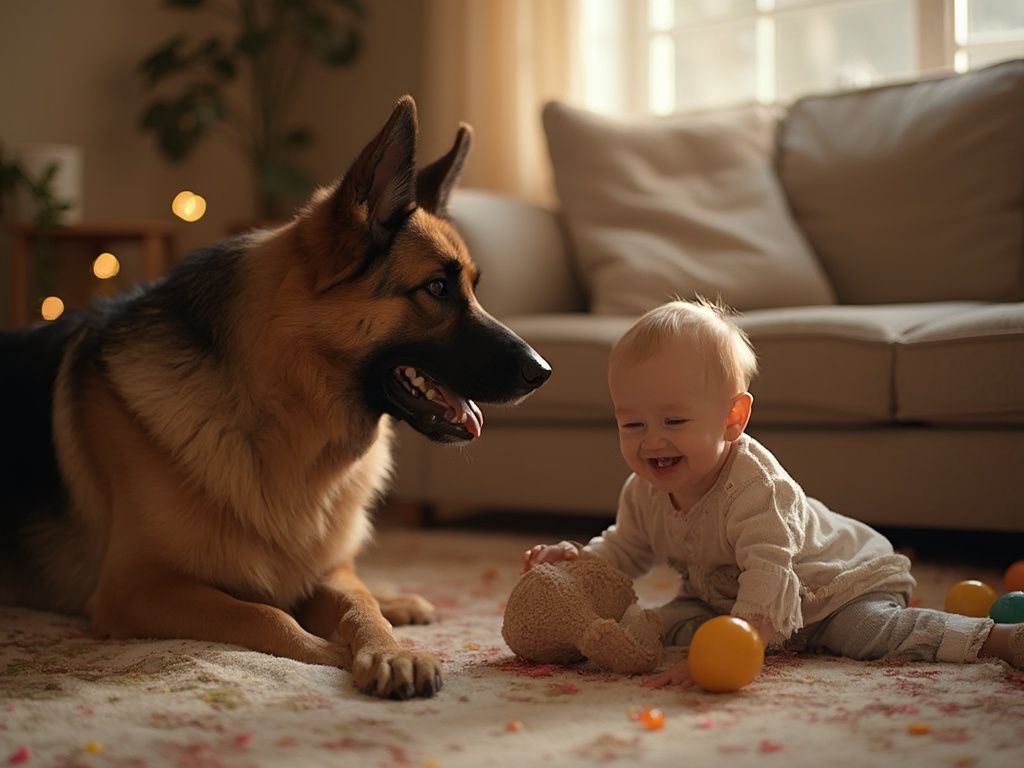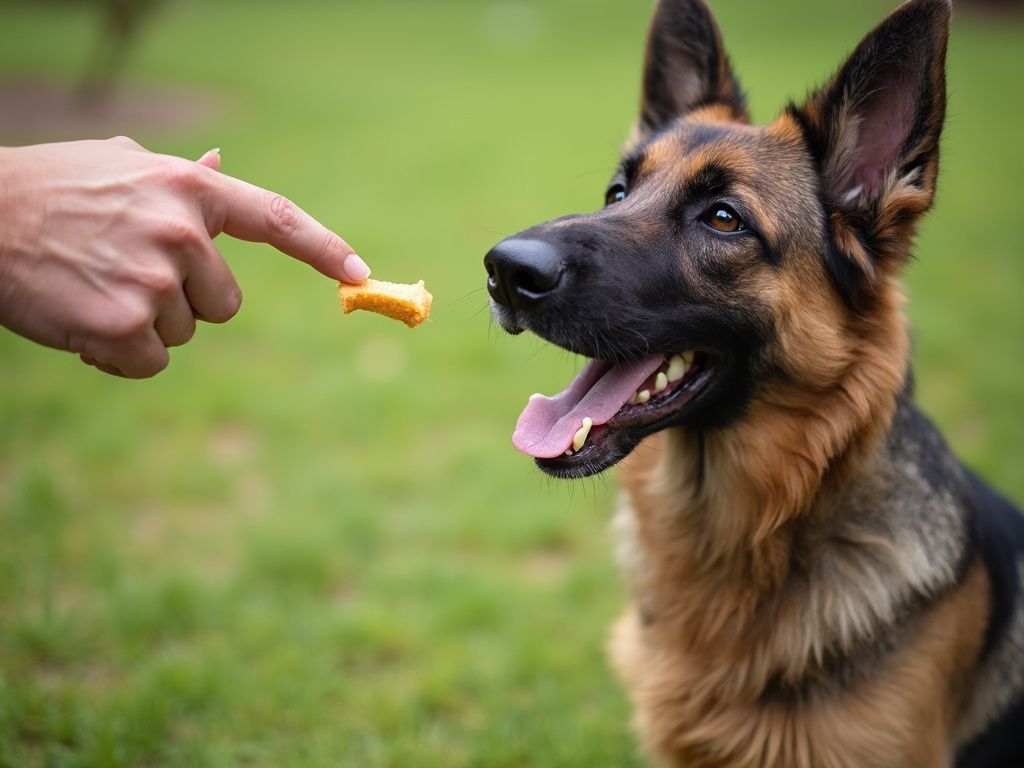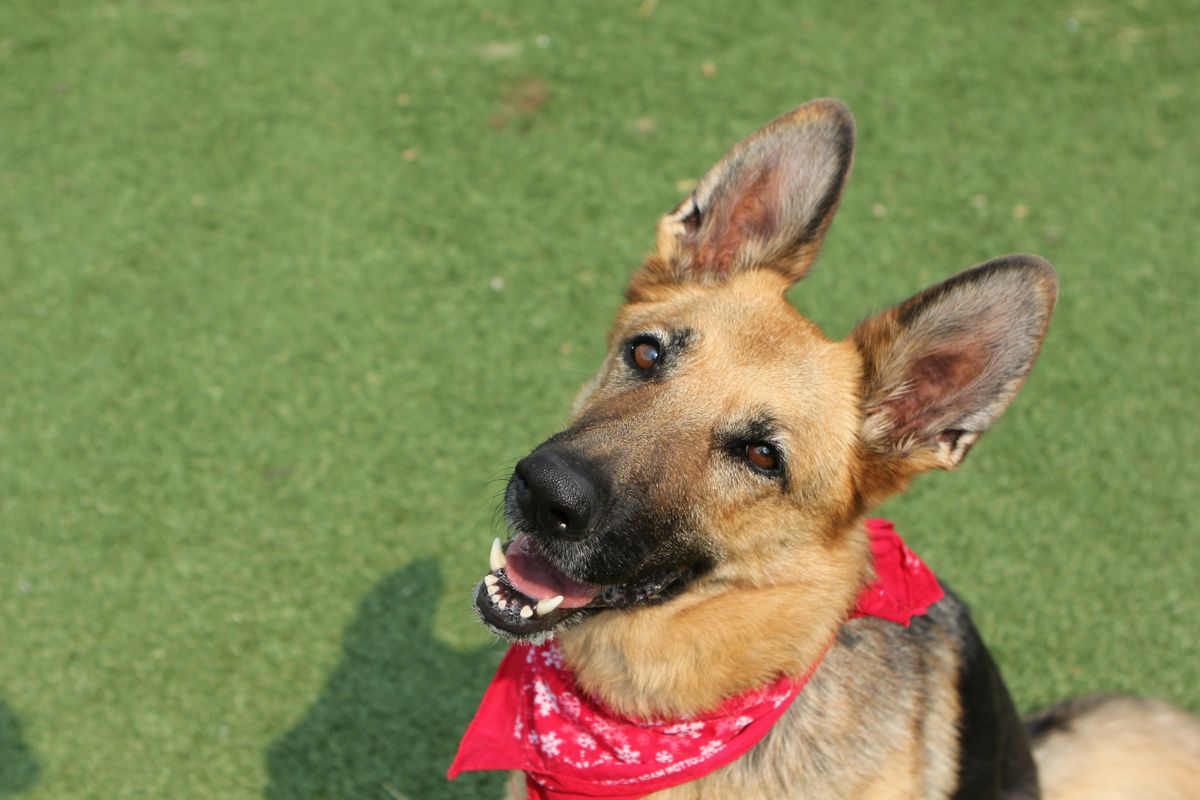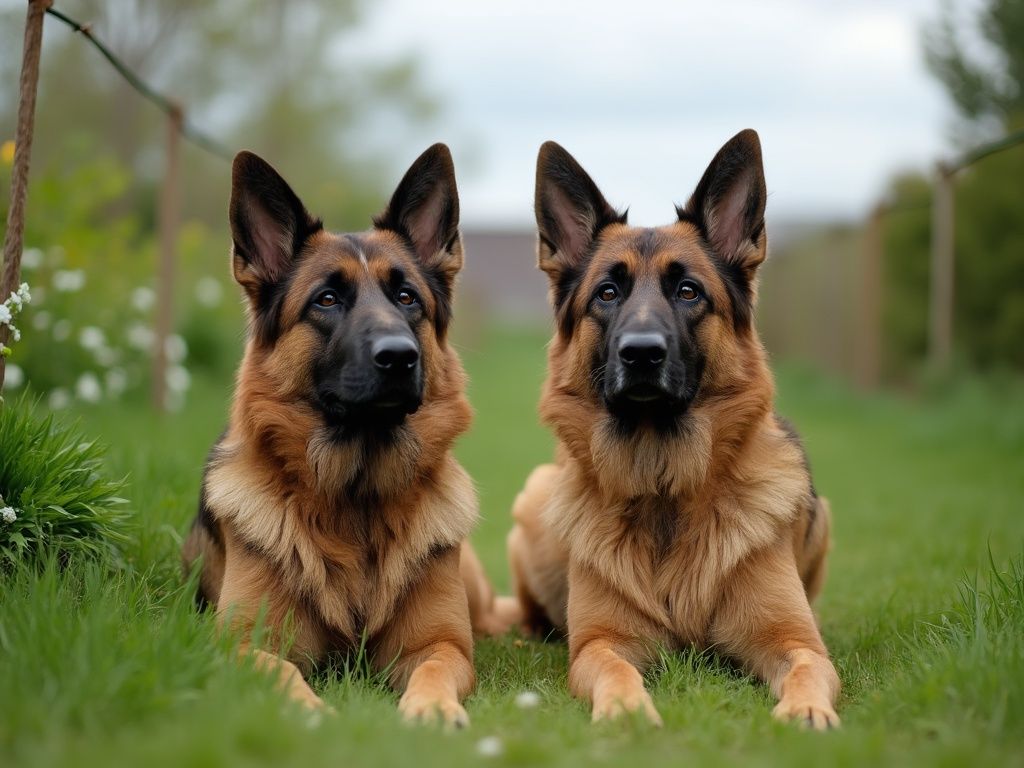The German Shepherd is much more than just a guard dog. Known for its intelligence, versatility, and unwavering loyalty, this iconic breed holds a special place in the hearts of dog lovers and professionals worldwide.
Did you know that the German Shepherd is the second most registered breed in the United States and Europe, just behind the Labrador? Appreciated both for its role in the police force and in families, this dog is a true living legend.
Origins of the German Shepherd #
The German Shepherd has its roots in Germany, where it was developed in the late 19th century. Max von Stephanitz, considered the “father” of the breed, wanted to create the perfect herding dog, both robust, intelligent, and loyal. By crossing several lines of local working dogs, he created a versatile dog, initially intended to watch over and guide flocks.
With industrialization, the need for herding dogs decreased, but the popularity of the German Shepherd continued to grow. Its adaptability quickly led it to fulfill various roles: police dog, search and rescue, detection, and even a famous actor (remember the German Shepherd’s performance in I Am Legend).
Today, the German Shepherd is recognized as one of the most versatile breeds in the world, both a companion and an accomplished professional.
Physical Characteristics of the German Shepherd #
Size and Weight #
The German Shepherd is a large dog with an elegant and athletic silhouette. Here are the typical measurements:
| Sex | Height (inches) | Weight (pounds) |
|---|---|---|
| Male | 24-26 | 66-88 |
| Female | 22-24 | 48-70 |
With its muscular build and harmonious proportions, this dog impresses with its power and agility.
Coat Color #
The German Shepherd’s coat is dense and double-layered, with a protective outer layer and a soft undercoat. The most common colors include:
- Black and tan (the most common)
- Sable
- Solid black
- White (though less common and sometimes controversial)
The coat requires regular maintenance, especially during seasonal shedding.
Specific Features #
The German Shepherd is known for its erect and alert ears, which accentuate its intelligent expression. Its bushy tail, carried low, is another distinctive trait. Its almond-shaped eyes reflect its attentive and affectionate nature.
Behavior of the German Shepherd #
The German Shepherd is renowned for its intelligence, loyalty, and balanced temperament. It is a versatile dog, well-suited to family life as well as demanding professional roles. Well-socialized and properly trained, it is one of the most reliable and protective dogs.
Behavior with Children #
With children, the German Shepherd shows great gentleness and patience. Its protective instinct drives it to watch over the youngest family members, making it an excellent companion for families. However, due to its size and strength, supervision is necessary, especially when children are very young.
Some tips for a good coexistence:
- Socialize your German Shepherd from a young age so it is comfortable with children.
- Teach children to respect the dog’s boundaries (not pulling on its ears or tail, for example).
- Encourage positive interactions through supervised play.

Behavior with Other Animals #
The German Shepherd can coexist with other animals, but a gradual introduction is essential. Its natural guarding and herding instincts may manifest, especially towards smaller animals. Well-socialized, it can live harmoniously with cats or other dogs.
Points to consider:
- Favor meetings on neutral ground to avoid territorial behavior.
- Reinforce positive interactions with treats and encouragement.
- Be vigilant about its herding instinct, which might lead it to “herd” other animals.
Health of the German Shepherd #
Life Expectancy #
The German Shepherd has an average life expectancy of 10 to 14 years, which is relatively long for a large dog. A suitable diet, regular exercise, and preventive veterinary care are essential for maintaining good health.
Common Diseases #
Like many large breeds, the German Shepherd is prone to certain hereditary or morphology-related diseases. Here is a table of the most common diseases:
| Disease | Description | Frequency |
|---|---|---|
| Hip dysplasia | Joint malformation causing pain. | High |
| Elbow dysplasia | Joint anomaly affecting mobility. | Medium |
| Degenerative myelopathy | Progressive neurological disease. | Medium |
| Idiopathic epilepsy | Neurological disorder causing recurrent seizures | Medium |
| Gastric bloat | Stomach torsion, a life-threatening emergency. | Low |
Regular screenings and veterinary follow-ups can help prevent or manage these issues.
Heart and Respiratory Rates of the German Shepherd #
Thanks to the many German Shepherds equipped with Minitailz, we have recorded the following figures in healthy dogs:
| Median Heart Rate | Median Respiratory Rate |
|---|---|
| 58.4 BPM 50% of them have a rate between 54.2 and 62.5 BPM |
16.4 RPM 50% of them have a rate between 14.5 and 18.7 RPM |
Training the German Shepherd #
Training the German Shepherd is crucial to fully harness its exceptional intelligence and loyalty. Although this breed is known for its ease of learning and dedication, structured training from a young age is essential to prevent undesirable behaviors and make it a balanced companion.
✔️ Positive Training Methods #
The German Shepherd responds extremely well to training methods based on positive reinforcement. These techniques involve rewarding good behaviors with treats, verbal praise, or petting. Here’s how to implement these methods:
- Use tasty rewards to motivate your dog.
- Warmly praise it after each good action.
- Avoid punishments, which may cause anxiety and reduce trust in the owner.
Training sessions should be short and varied (10 to 15 minutes) to maintain its attention and prevent boredom. Repetition, patience, and consistency are the keys to success.
✔️ Importance of Early Socialization #
Early socialization is crucial for the German Shepherd, especially due to its natural guarding instincts. Good socialization from a young age ensures that your dog will be comfortable in various environments and with unfamiliar people or animals.
Here are some steps for successful socialization:
- Expose your puppy to people of all ages and different backgrounds.
- Introduce it to other dogs and pets gradually.
- Familiarize it with varied environments (parks, busy streets, public transport).
- Acclimate it to common noises like vacuum cleaners, horns, or heavy rain.
A well-socialized German Shepherd will be more serene and confident in adulthood.
✔️ House Training #
House training is an essential step, often quick if clear routines are established. Here are some practical tips:
- Establish a routine: take your puppy out at strategic times (upon waking, after meals, after playtime).
- Use a dedicated space: choose a specific spot for its needs so it associates this place with its toilet.
- Reward immediately: praise it every time it relieves itself outside.
With patience and consistency, the German Shepherd can master house training in a few weeks.
✔️ Teaching Basic Commands #
Teaching basic commands is essential for ensuring good control of your German Shepherd. This breed excels in learning and can quickly master commands such as:
- “Sit”: useful for controlling its enthusiasm.
- “Down”: promotes calmness.
- “Heel”: improves leash walks.
- “Stay”: essential for avoiding potentially dangerous situations.
For each command, use rewards and repeat regularly. Once acquired, these basics allow for progress to more complex orders.

❌ Undesirable Behaviors and How to Manage Them #
Despite its reputation as an obedient dog, the German Shepherd can exhibit some undesirable behaviors, often related to a lack of exercise or mental stimulation. Here are common issues and their solutions:
-
Excessive Chewing
- Cause: Boredom, stress, or teething in puppies.
- Solution: Provide sturdy chew toys and ensure it gets enough exercise.
-
Pulling on the Leash
- Cause: Enthusiasm or lack of leash training.
- Solution: Use an anti-pull harness and practice heel walking.
-
Jumping on People
- Cause: Excitement or lack of training.
- Solution: Ignore it when it jumps and reward it when it keeps its paws on the ground.
-
Excessive Barking
- Cause: Guarding instinct or boredom.
- Solution: Identify the cause of barking and redirect its attention with commands or games.
Training Exercise Examples #
The German Shepherd needs mental and physical stimulation to remain balanced. Here are some exercises that combine fun and education:
- Object Retrieval: Encourages its working instinct and reinforces obedience.
- Treat Search: Stimulates its sense of smell and concentration.
- Agility Course: Ideal for channeling its energy and strengthening your bond.
Regular and playful training is essential for a happy and well-adjusted German Shepherd.
Character and Lifestyle of the German Shepherd #
The German Shepherd is known for its exceptional temperament. Loyal, intelligent, and protective, it adapts well to both family life and professional missions. Here’s an overview of its character and the ideal conditions for its well-being.
Physical Activity and Exercise #
The German Shepherd is an active breed, requiring a high level of exercise to stay balanced. It is ideal for dynamic and sporty people.
- Daily Needs: At least 1.5 to 2 hours of exercise per day, including walks, games, and stimulating activities.
- Recommended Activities: Canicross, agility, or fetch games are perfect for this breed.
- Risks of Boredom: Without sufficient physical and mental stimulation, the German Shepherd may develop destructive behaviors or anxiety.
Indoor Character #
Although active outdoors, the German Shepherd can be calm and composed indoors, provided it has expended its energy. Its behavior largely depends on the education received and how its needs are met.
- Typical Behavior: Affectionate, often close to its owners, it may follow its humans around the house.
- Preferences: It enjoys environments where it can be involved in daily life and stay close to its family.
Character with Family and Other Animals #
The German Shepherd is extremely loyal to its family. Naturally protective, it is ready to do anything to ensure their safety.
- With Children: This dog is very patient and protective, making it an excellent companion for families. Supervision is still necessary with young children due to its strength.
- With Other Animals: The German Shepherd can coexist with other animals, but early socialization is essential to prevent dominant behaviors.
Living Environment #
The German Shepherd can adapt to different environments, but it thrives particularly in homes with gardens. However, even in an apartment, it can be happy if its exercise and stimulation needs are met.
- Outdoor Spaces: A fenced garden is ideal to provide it with a space to expend energy.
- Apartment Living: Possible with regular walks and activities.
- Compatibility with Various Lifestyles: It suits both families and single or sporty individuals.
Grooming and Hygiene of the German Shepherd #
The German Shepherd, with its double and dense coat, requires regular care to maintain its health and appearance. Here are the main aspects to consider for ensuring its well-being.
Brushing and Coat Care #
The German Shepherd’s coat is subject to significant seasonal shedding. It is essential to brush it regularly to remove dead hair and prevent tangles. Here are some tips:
- Frequency: Brush it 2 to 3 times a week, and daily during shedding periods.
- Recommended Tools: Use a metal brush or undercoat rake, suitable for its thick coat.
- Tip: An occasional bath (every 2 to 3 months) helps keep its coat clean, but avoid washing it too often to preserve the natural oils in its skin.
Ear Hygiene #
The German Shepherd’s erect ears are less prone to infections than those of breeds with floppy ears, but they still require regular cleaning. Check them weekly for redness or unusual odors, signs of infection.
- Frequency: Clean them once a week with a suitable solution.
- Tip: Avoid pushing the cotton too far into the ear to prevent irritation.

Dental Hygiene #
Dental problems can be common in large dogs. Prevent them with regular care:
- Frequency: Brush your dog’s teeth 2 to 3 times a week with a dog toothbrush and toothpaste.
- Other Solutions: Offer chew toys or dental treats to reduce tartar buildup.
Diet #
The German Shepherd’s diet should be adapted to its size, age, and activity level. Favor high-protein, vitamin, and mineral-rich kibble to support its health and energy. Here are some recommendations:
- Daily Portions: About 10.5 to 17.5 ounces of high-quality kibble, divided into two meals per day.
- Weight Monitoring: This breed is predisposed to certain joint problems, exacerbated by overweight. Be sure to control its weight.
Adoption and Cost of the German Shepherd #
Owning a German Shepherd is a rewarding experience, but it comes with specific costs that are important to consider before adoption.
Adoption Price #
The cost of a German Shepherd varies depending on its origin:
- Adoption from a shelter: Around 200 to 300 €, often including vaccination, sterilization, and identification.
- Purchase from a breeder: Between 800 and 1,500 €, or more for puppies from working or show lines.
Annual Cost of the German Shepherd #
The German Shepherd is a dog that requires a significant budget to meet its needs. Here is an estimate of annual expenses:
| Category | Estimated Annual Cost |
|---|---|
| Food | 500 to 800 € |
| Veterinary Care | 200 to 500 € (excluding unforeseen events) |
| Health Insurance | 200 to 600 € |
| Accessories | 100 to 200 € |
| Total Annual | 1,000 to 2,100 € |
Other Possible Expenses #
- Neutering/Spaying: Between 150 and 400 €.
- Dog Training: Group or individual classes, costing between 20 and 50 € per session.

The German Shepherd is an exceptional dog, combining intelligence, loyalty, and versatility. However, it requires a serious commitment, both in terms of time and finances. By taking care of its training, hygiene, and health, you will enjoy a faithful and devoted companion, capable of thriving in many environments. Whether to protect your home or share your daily life, the German Shepherd will occupy a unique place in your life!

